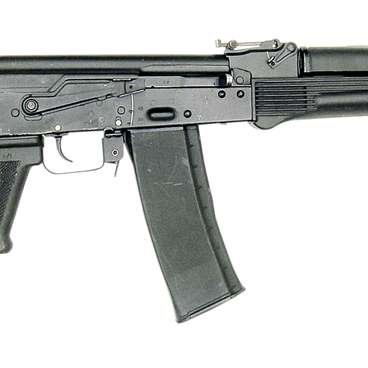In the 2000s, the Izhevsk Machine-Building Plant (also known as “Izhmash”) developed the new fifth-generation Kalashnikov assault rifle on its own initiative. The government did not support the enterprise because more than 17 million old assault rifles were piled up in warehouses.
Testing of the prototype with the working name AK-12 began in 2011. In June 2012, Vladimir Zlobin, chief designer of “Izhmash”, held a presentation on AK-12 for representatives of the Russian Ministry of Defense, Ministry of Internal Affairs and Federal Security Service. The members of the commission noted that the new assault rifle is steadier when firing than previous models.
That summer the assault rifle was presented at the second International Forum “Technologies in Mechanical Engineering” in Zhukovsky. The military was offered to include the AK-12 rifles in the “Ratnik” project. This project included the creation of a new outfit — “the soldier’s kit of the future” — and a new rifle was considered a part of it. However, the designers from “Izhmash” did not have time to create a version of the assault rifle chambered for the most common 7.62×39-millimeter caliber. The Ministry of Defense signed a contract for further development with the Degtyaryov Plant (also known as ZiD, one of the most important weapon and vehicle producing enterprises of Russia) and the AK-12 was finalized at the expense of “Izhmash”.
In 2014, “Izhmash” was transformed into the Kalashnikov Concern. The management decided to concentrate on the development of the AK-400 model, but leading designer Dmitry Dolganov continued to work on the AK-12. At the Army-2016 forum, Kalashnikov Concern presented an updated version of the assault rifle. Unlike the AK-400 project, in the new AK-12 the entire mechanical part was created anew in a computer-aided design system. The new assault rifle had improved ergonomics and became fully symmetrical. Therefore, both right- and left-handed shooters can fire the AK-12 equally effectively.
The standard magazine case, which is fully interchangeable with the AK-74, is designed with transparent inserts, through which the number of remaining rounds can be determined. The fore-end, upper handguard and receiver cover were equipped with Picatinny rails. These are the bracket stays for mounting a variety of attachments — from barrel sights to tactical flashlights and bipods. The rifle was equipped with a case for storing electric batteries or medicines.
The AK-12 rifle was successfully tested at the third Central Research Institute of the Ministry of Defense. It was used as the basis for the AK-15 chambered for the 7.62×39-millimeter cartridge, as well as the civilian AK TR3 carbine and RPK-16 light machine gun. On January 29, 2018, the AK-12 was adopted by the Russian Army, Airborne Forces and Marines.
Testing of the prototype with the working name AK-12 began in 2011. In June 2012, Vladimir Zlobin, chief designer of “Izhmash”, held a presentation on AK-12 for representatives of the Russian Ministry of Defense, Ministry of Internal Affairs and Federal Security Service. The members of the commission noted that the new assault rifle is steadier when firing than previous models.
That summer the assault rifle was presented at the second International Forum “Technologies in Mechanical Engineering” in Zhukovsky. The military was offered to include the AK-12 rifles in the “Ratnik” project. This project included the creation of a new outfit — “the soldier’s kit of the future” — and a new rifle was considered a part of it. However, the designers from “Izhmash” did not have time to create a version of the assault rifle chambered for the most common 7.62×39-millimeter caliber. The Ministry of Defense signed a contract for further development with the Degtyaryov Plant (also known as ZiD, one of the most important weapon and vehicle producing enterprises of Russia) and the AK-12 was finalized at the expense of “Izhmash”.
In 2014, “Izhmash” was transformed into the Kalashnikov Concern. The management decided to concentrate on the development of the AK-400 model, but leading designer Dmitry Dolganov continued to work on the AK-12. At the Army-2016 forum, Kalashnikov Concern presented an updated version of the assault rifle. Unlike the AK-400 project, in the new AK-12 the entire mechanical part was created anew in a computer-aided design system. The new assault rifle had improved ergonomics and became fully symmetrical. Therefore, both right- and left-handed shooters can fire the AK-12 equally effectively.
The standard magazine case, which is fully interchangeable with the AK-74, is designed with transparent inserts, through which the number of remaining rounds can be determined. The fore-end, upper handguard and receiver cover were equipped with Picatinny rails. These are the bracket stays for mounting a variety of attachments — from barrel sights to tactical flashlights and bipods. The rifle was equipped with a case for storing electric batteries or medicines.
The AK-12 rifle was successfully tested at the third Central Research Institute of the Ministry of Defense. It was used as the basis for the AK-15 chambered for the 7.62×39-millimeter cartridge, as well as the civilian AK TR3 carbine and RPK-16 light machine gun. On January 29, 2018, the AK-12 was adopted by the Russian Army, Airborne Forces and Marines.

